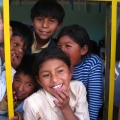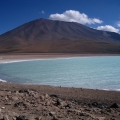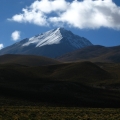- Information
- History
- Weather
- When to go
- Good to know
- Culture
- Visa and Passport
- Food
- Nightlife
- Glossary
- Traveler Advice
- Forums
48HourVisit.com
 Planning a short visit? Check out 48HourVisit.com, your online guide for short stays and weekend getaways.
Planning a short visit? Check out 48HourVisit.com, your online guide for short stays and weekend getaways. Ad
The Glossary
Landlocked by the Cordillera Real and the Amazon Basin, Bolivia's location makes it perhaps the highest and most rugged nation in South America. In fact, it has often been dubbed as the “Tibet of the Americas.” It is incredibly rich in natural resources, laying claim to Salar de Uyuni, the world's largest salt flat, as well as El Cerro Mutun which contains the largest iron ire deposits on the planet.
Despite this apparent abundance, Bolivia has remained as the poorest in the entire continent. This dilemma is believed to be caused by its reluctance to exploit nature - unearthing its minerals would mean the uprooting of forests and extensive quarrying. The downside of course, is that roughly 64 percent of its population lives below the poverty line. Not to mention that it has largely been forgotten by tourists.
Indigenous Nation
Bolivia has a colorful history spanning millennia, two thousand of which had passed with the country being under foreign rule. Perhaps the most prominent of these was being a part of the legendary Inca Empire. The Spanish forces occupied the land in the 16th century under the Viceroyalty of Peru, until it finally gained independence in 1825. Since then, however, the country has battled not enemy soldiers, but political instability and economic woes.
There is one bright spot left by foreign occupation on Bolivia, though: the nation's incredible multiethnicity. Of its more than nine million-strong population, over 60 percent claim to have indigenous heritages. It has some 30 ethnic groups, such as the Aymara, Guarani, and Quechua, as well as exotic races like Amerindians, Mestizos, and Asians.
Mind-Boggling Landscape
While the nation may be financially-challenged, there is no denying that Bolivia is a place of natural beauty. It is known as the home of one of the largest lakes in South America - Lake Titicaca. The Yungas Jungle is a sanctuary for diverse flora and fauna, while also boasting mountain bike trail touted as the most dangerous road in the world.
Bounded by the Cordillera Real mountains, mountain climbing is also at a premium here, especially the 6,452-meter high Nevado Sajama which is the tallest in the land. To the southeast are wildlife-rich grasslands, while the town of Sorata is an ideal travel base for trekkers and hikers.
Bolivia Traveler Advice
Bolivia photography
 Bolivian kids at school by Communitriper
Bolivian kids at school by Communitriper
 Sulphar lake in bolivia by Communitriper
Sulphar lake in bolivia by Communitriper
 Snowy mountains in Bolivia by Communitriper
Snowy mountains in Bolivia by Communitriper
User blogs:
What to see in Sydney, Australia
Sydney is a beautiful and livable city and is one of the most famous and representative in Australia. It 's definitely the cultural capital, although the administrative capital is the nearby Canberra. Despite his poor beginnings as a British penal colony, now Sydney has a diverse population that seems to live quite well by its variety. This city has many hotels to choose from. Pick up one that has ... Read full Blog post

A trip to Siargao
Seeing people that are “living their dream” is always inspirational, it looks so rewarding and peaceful, breaking from the chains of conformism, doing what you always dreamt to do since you were a kid, it doesn’t have to make you huge loads of money or bring you world fame just a feeling of self fulfillment, last time I checked, you can’t put a price tag on that one. In Siargao ... Read full Blog post

Some of the best natural parks in the US
The natural parks of the United States are very different from what we are used to seeing in the rest of the world and in most travel blogs and travel news. Large, spectacular and complete, without a doubt a very preferred destination for holidays by the Americans. There are 58 National Parks in the U.S. well preserved and operated by the Federal National Park Service. Besides these you can ... Read full Blog post

San Gimignano and San Pellegrino
Night falls on the flourishing and industrious San Gimignano, its 72 towers stand on the low roofs of the houses lit by the moon. This is not a luxury travel spot but is something you don't see every day. In the distance the clatter of hooves echoed tired in the Via Francigena. The hand of the blacksmith stops beating, the frame of the weaver becomes silent, the streets of the tank only a concert ... Read full Blog post
Destinations
See AllIn our Magazine
Summer Destination to Avoid: Gulf of Mexico
 EPA is failing to do their job monitoring the air and reporting factual data. The people need to be made aware that their lives and long term livelihood are at stake because of the air quality in Gulf of Mexico.
EPA is failing to do their job monitoring the air and reporting factual data. The people need to be made aware that their lives and long term livelihood are at stake because of the air quality in Gulf of Mexico.
How to Avoid Traveling Troubles
 Traveling to a certain destination might not become memorable if there are too many troubles along the way. Remember that even the best trips are usually not trouble-free. Follow these tips that help lessen the hassles.
Traveling to a certain destination might not become memorable if there are too many troubles along the way. Remember that even the best trips are usually not trouble-free. Follow these tips that help lessen the hassles.
Unique Toys from Japan
 Japan is known for its fascinating, and sometimes, eccentric culture. From anime, karaoke, to advanced technology, the Land of the Rising Sun always has something unique to offer.
Japan is known for its fascinating, and sometimes, eccentric culture. From anime, karaoke, to advanced technology, the Land of the Rising Sun always has something unique to offer.





